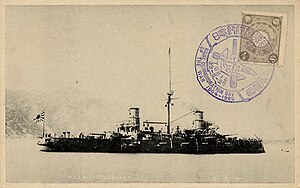Kasuga-class cruiser
 Kasuga in 1900
| |
| Class overview | |
|---|---|
| Builders | Ansaldo, Genoa, Italy |
| Operators | |
| Built | 1902–1904 |
| In commission | 1904–1945 |
| Completed | 2 |
| Lost | 2 |
| General characteristics | |
| Type | Armored cruiser |
| Displacement | list error: <br /> list (help) 7,628 long tons (7,750 t) Kasuga 7,698 long tons (7,822 t) Nisshin |
| Length | list error: <br /> list (help) 108.8 m (356 ft 11 in) w/l 111.73 m (366 ft 7 in) o/a |
| Beam | 18.9 m (62 ft 0 in) |
| Draught | 7.32 m (24 ft 0 in) |
| Propulsion | list error: <br /> list (help) 2 shaft Reciprocating Vertical Triple Expansion (VTE) Engines 8 boilers 13,500 shp (10,100 kW) |
| Speed | 20 knots (23 mph; 37 km/h) |
| Range | 7,000 nmi (13,000 km) at 10 kn (12 mph; 19 km/h) |
| Complement | 600 |
| Armament | list error: <br /> list (help) • 1 × 10-inch (254 mm) gun (Kasuga only) • 4 × 8-inch (203 mm) guns (2 in Kasuga) |
| Armour | list error: <br /> list (help) Main Belt: 70–150 mm (2.8–5.9 in) Deck: 25–38 mm (0.98–1.50 in) Barbette, Turret, Casemate & Conning tower: 100–150 mm (3.9–5.9 in) |
The Kasuga-class cruiser (春日型巡洋艦, Kasuga-gata junyōkan) was an armored cruiser class of the Imperial Japanese Navy based on the Giuseppe Garibaldi-class cruisers developed by Italy at the end of the 19th century.
Background
The Italian Giuseppe Garibaldi-class design was a private venture by the Italian firm of Gio. Ansaldo & C., which was hoping to profit from the need for the world's navies to modernize towards heavily armored steam warships. The design was so popular that between 1894 and 1902 ten cruisers were purchased by four different countries: The first five by the Italian Navy, four by the Argentine Navy and one by the Spanish Navy.
The Italian Navy ordered the final two vessels of this class in 1902 as the Mitre and Roca. Sold to the Argentine Navy before completion, they were renamed as the Rivadavia and the Mariano Moreno. The Argentines in turn sold them to the Imperial Japanese Navy before final completion in 1904, and they were renamed the Kasuga and Nisshin.
Design
Designed by Edoardo Masdea, the Garibaldi-class cruiser was a hybrid between a cruiser and a battleship. At 20 knots (37 km/h) maximum speed, the design was slightly slower than contemporary cruisers, but was very heavily armed and also very heavily armored, in a package with very low displacement and moderate dimensions.
The class was unusual in that they did not have a uniform main armament. Some had single 10-inch (254 mm) guns in gun turrets fore and aft; others (including the Kasuga) had a mixed armament of a single 10-inch (254 mm) gun in one turret and another turret with twin 8-inch (203 mm) guns. A third variation (including the Nisshin) was a uniform armament of four 8-inch (203 mm) guns, twin gun turrets fore and aft.
Ships in class
Kasuga was built by Ansaldo at Genoa, Italy. She was to be named Mitre but was renamed as Rivadavia by Argentina. Launched on 22 October 1902 and completed on the 7 January 1904, she served in the Russo-Japanese War and took part in the Battle of the Yellow Sea and again at the Battle of Tsushima. After 1922, she was partially disarmed as part of the Washington Naval Treaty and used as a training ship until finally scrapped in 1948.

Nisshin was also built by Ansaldo at Genoa. She was to be named Roca but was renamed as Mariano Moreno by Argentina. She was launched on 9 February 1903 and completed on the 7 January 1904. She served in the Russo-Japanese War and was severely damaged during the Battle of the Yellow Sea and again at the Battle of Tsushima. After 1922, as part of the Washington Naval Treaty she was partially disarmed and used as a training ship. Nisshin was finally expended as a target and sunk in 1936.
Afterwards
The success of the Japanese Navy in using armored cruisers in the line of battle during the Russo-Japanese War of 1905 drew considerable attention from navies and ship designers worldwide. The armored cruiser design soon evolved into the dreadnought armored cruiser and finally into the battlecruiser, which would be the most glamorous type of the world's warships until discredited at the Battle of Jutland, eleven years after Tsushima.
See also
![]() Media related to Kasuga class armored cruisers at Wikimedia Commons
Media related to Kasuga class armored cruisers at Wikimedia Commons
References
- Conway's All the World’s Fighting Ships 1860-1905
- Delorme, Pierre, Les Grandes Batailles de l'Histoire, Port-Arthur 1904, Socomer Editions (French)
- Dull, Paul S. (1978) A Battle History of The Imperial Japanese Navy ISBN 0-85059-295-X
- Gardiner, Robert (editor) (2001) Steam, Steel and Shellfire, The Steam Warship 1815–1905, ISBN 0-7858-1413-2
- Kofman, V.L. Armored Cruiser Type Garibaldi, Morskaya Kollektsia 3-1995
